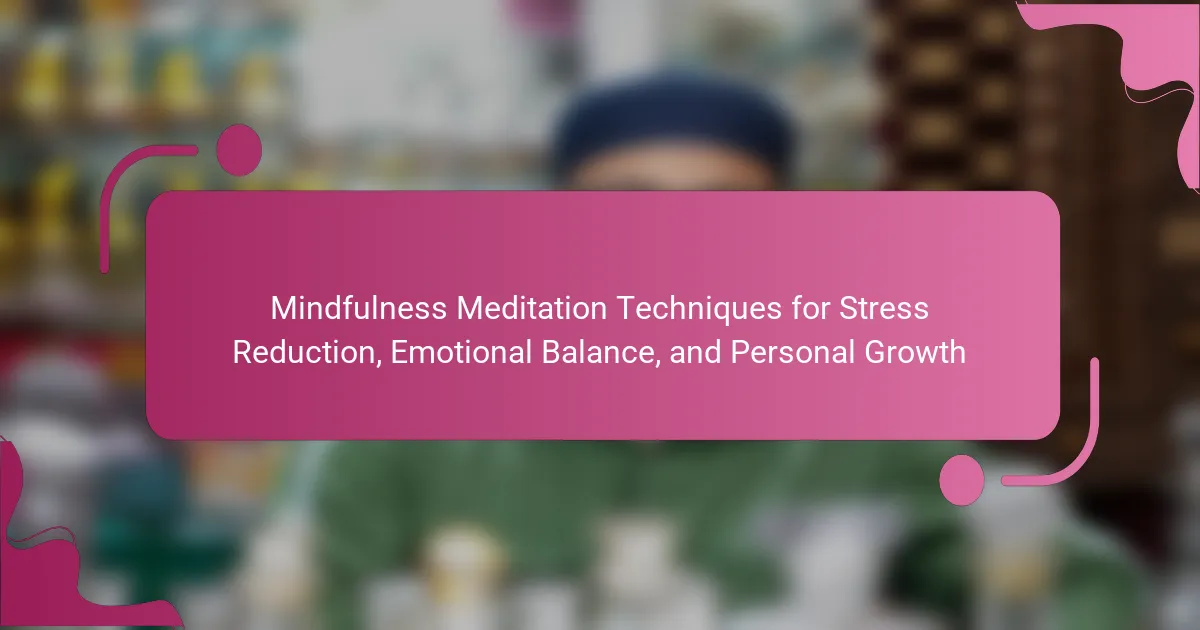Mindfulness meditation techniques effectively reduce stress, enhance emotional balance, and promote personal growth. These practices encourage present-moment awareness, fostering relaxation and resilience. Techniques such as breath awareness and body scan are accessible for beginners, while advanced methods like sound meditation and mindful movement offer deeper insights. Regular practice leads to improved emotional regulation and clarity, making mindfulness a valuable tool for personal development.
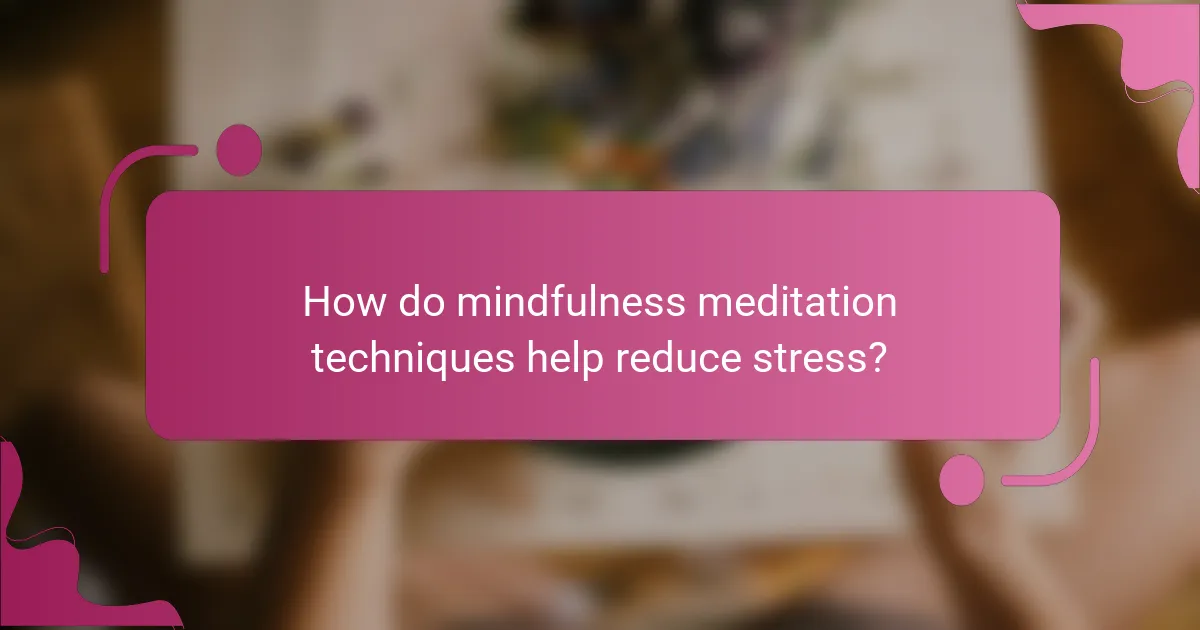
How do mindfulness meditation techniques help reduce stress?
Mindfulness meditation techniques significantly reduce stress by promoting relaxation and enhancing emotional regulation. These techniques encourage present-moment awareness, which helps individuals detach from stressors and cultivate a sense of calm. Regular practice can lower cortisol levels, improve focus, and increase resilience. As a result, practitioners often experience greater emotional balance and personal growth, making mindfulness a valuable tool for managing stress effectively.
What physiological changes occur during mindfulness meditation?
Mindfulness meditation induces several physiological changes that enhance well-being. These changes include reduced heart rate, lower blood pressure, and decreased levels of the stress hormone cortisol. Additionally, mindfulness practice promotes increased gray matter density in brain regions associated with emotional regulation and self-awareness. As a result, practitioners often experience improved emotional balance and stress resilience.
Which mindfulness practices are most effective for stress relief?
Mindfulness practices like meditation, deep breathing, and body scans effectively relieve stress. Each technique promotes emotional balance and personal growth.
Meditation enhances focus and reduces anxiety, with studies showing it lowers cortisol levels. Deep breathing exercises activate the body’s relaxation response, leading to immediate stress relief. Body scans increase body awareness, helping individuals identify and release tension.
Incorporating these practices into daily routines can significantly improve mental well-being. Regular engagement fosters resilience against stressors.
How can mindfulness meditation be integrated into daily routines for stress management?
Mindfulness meditation can be seamlessly integrated into daily routines by dedicating a few minutes each day to practice. Start with short sessions, ideally in the morning or during breaks, to foster emotional balance and reduce stress.
1. Begin with five minutes of focused breathing each morning.
2. Utilize mindfulness techniques during daily activities, such as eating or walking.
3. Schedule short breaks throughout the day to practice awareness.
4. Reflect on your experiences in a journal to enhance personal growth.
Consistent practice can significantly improve overall well-being and resilience against stress.
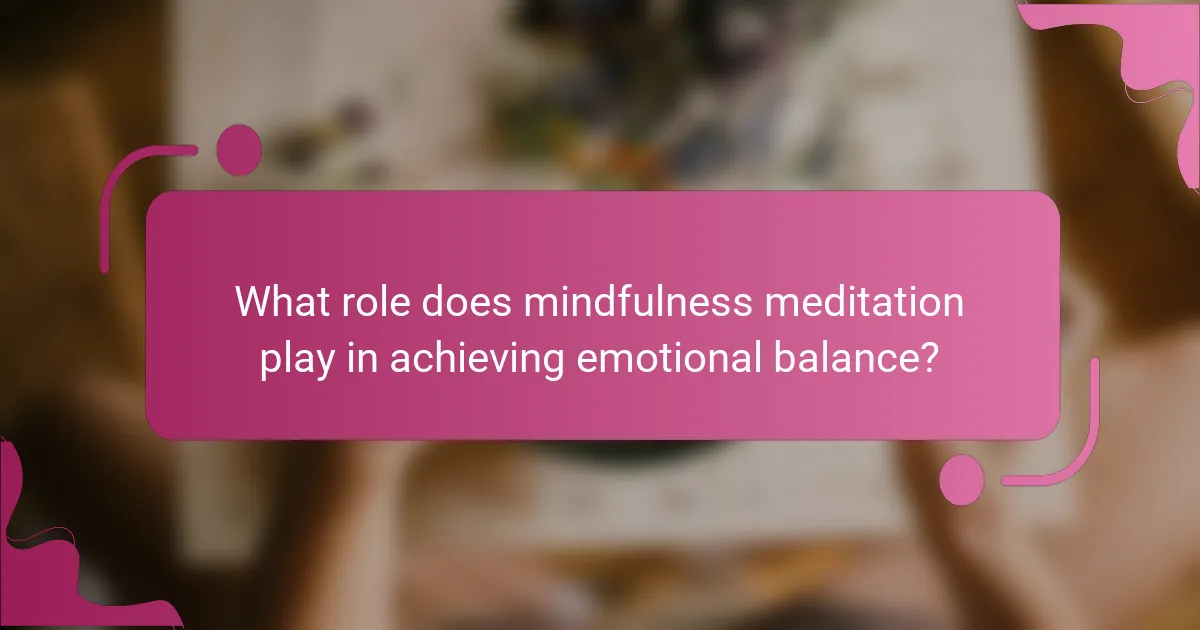
What role does mindfulness meditation play in achieving emotional balance?
Mindfulness meditation significantly aids in achieving emotional balance by promoting awareness and acceptance of thoughts and feelings. This practice reduces stress, enhances emotional regulation, and fosters resilience. Studies show that individuals who engage in mindfulness report lower levels of anxiety and depression. Regular practice can lead to structural changes in the brain, improving emotional processing and well-being.
How does mindfulness meditation influence emotional regulation?
Mindfulness meditation enhances emotional regulation by promoting awareness and acceptance of emotions. This practice helps individuals observe their feelings without judgment, leading to improved emotional balance. Research indicates that mindfulness meditation can decrease emotional reactivity and increase resilience during stressful situations. A study found that participants who practiced mindfulness reported lower levels of anxiety and depression, highlighting its effectiveness in fostering emotional well-being.
Which techniques promote emotional awareness and resilience?
Mindfulness meditation techniques enhance emotional awareness and resilience through focused attention and self-reflection. Techniques such as body scan, breath awareness, and loving-kindness meditation foster emotional balance. Regular practice improves stress reduction and promotes personal growth by increasing self-awareness and emotional regulation. For instance, studies show that mindfulness can decrease anxiety levels by up to 30%.
What are the long-term emotional benefits of consistent mindfulness practice?
Consistent mindfulness practice offers long-term emotional benefits, including enhanced emotional regulation, reduced anxiety, and increased resilience. Regular meditation fosters self-awareness, allowing individuals to better understand their emotions. This understanding leads to improved interpersonal relationships and greater overall satisfaction in life. Studies show that practitioners often report a significant decrease in stress levels and an increase in feelings of happiness and contentment over time.
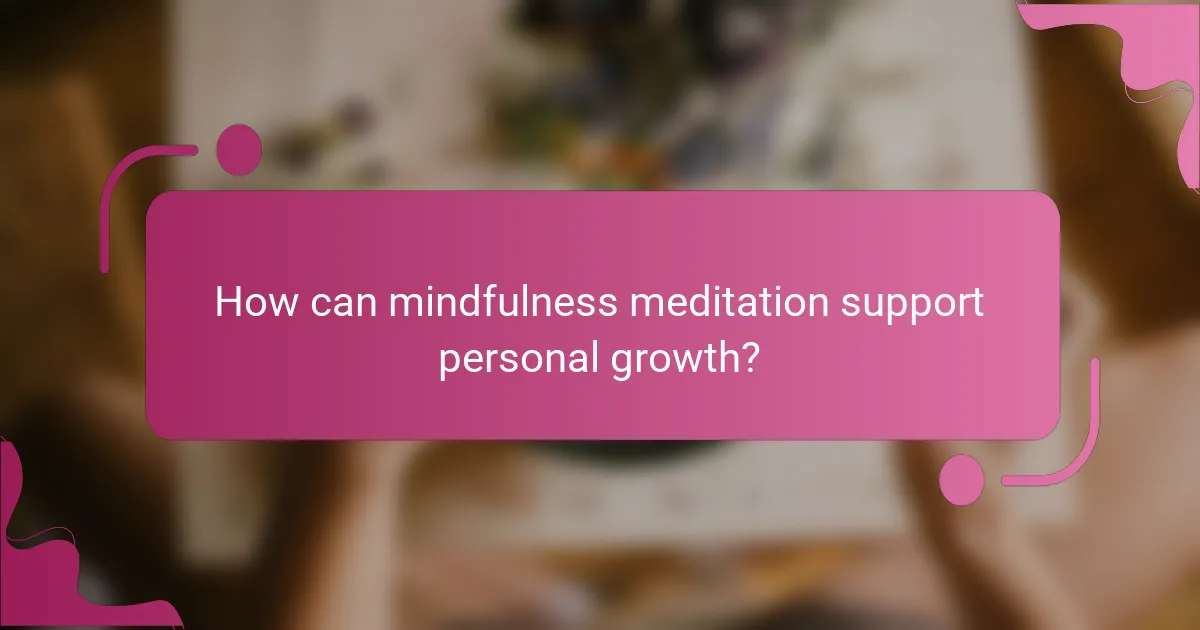
How can mindfulness meditation support personal growth?
Mindfulness meditation significantly supports personal growth by enhancing self-awareness and emotional regulation. Practicing mindfulness cultivates a deeper understanding of thoughts and feelings, leading to improved decision-making and resilience.
Research indicates that regular mindfulness practice reduces stress levels, promoting emotional balance. Participants often report increased clarity and focus, which are essential for personal development. Additionally, mindfulness fosters compassion and empathy, enriching interpersonal relationships.
Incorporating mindfulness techniques, such as breath awareness and body scan, can yield transformative benefits. These practices encourage individuals to live in the moment, reducing anxiety about the future and regrets from the past.
Ultimately, mindfulness meditation serves as a powerful tool for personal growth, enabling individuals to navigate life’s challenges with greater ease and confidence.
What are the key personal development aspects enhanced by mindfulness?
Mindfulness enhances personal development aspects such as stress reduction, emotional balance, and self-awareness. These techniques promote a deeper understanding of thoughts and feelings, leading to improved mental clarity and resilience. Regular practice can result in reduced anxiety levels, better emotional regulation, and increased focus on personal growth. Mindfulness fosters a non-judgmental awareness that encourages self-reflection and personal insight, ultimately contributing to overall well-being and life satisfaction.
How does mindfulness meditation foster self-awareness and self-acceptance?
Mindfulness meditation enhances self-awareness and self-acceptance by promoting present-moment awareness. This practice encourages individuals to observe their thoughts and feelings without judgment, fostering a deeper understanding of themselves. As a result, practitioners often experience reduced stress and improved emotional balance. Research indicates that regular mindfulness meditation can lead to increased emotional resilience and a greater sense of self-compassion. This transformative process supports personal growth by allowing individuals to embrace their authentic selves, leading to a more fulfilling life.
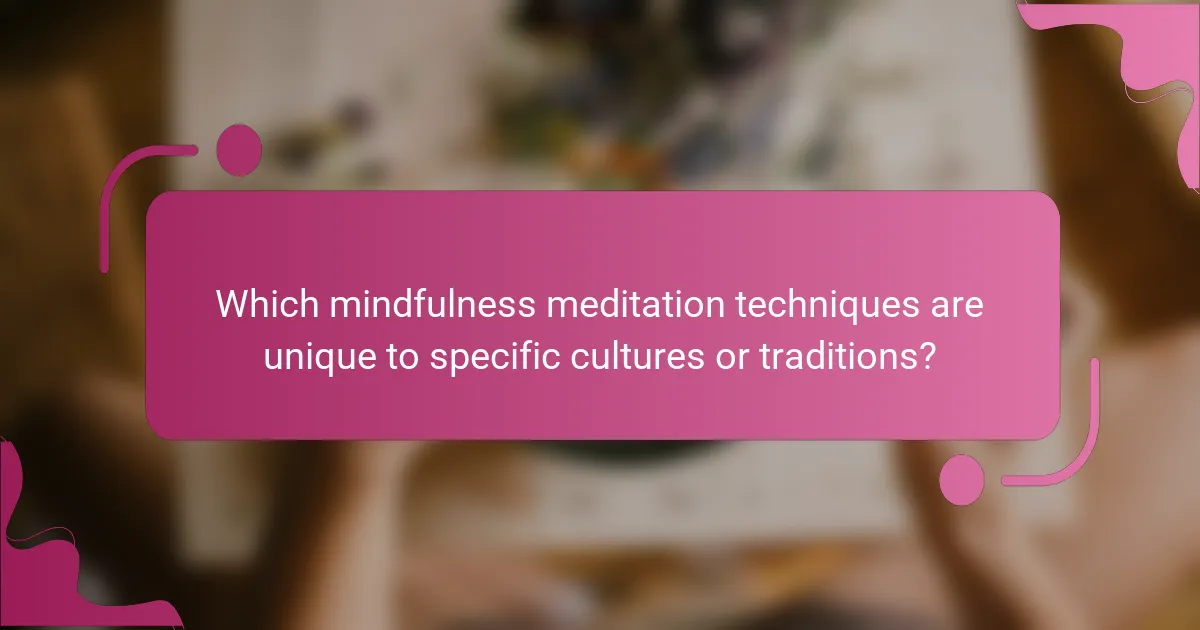
Which mindfulness meditation techniques are unique to specific cultures or traditions?
Mindfulness meditation techniques vary across cultures, each offering unique practices. Notable examples include Zen meditation from Japan, which emphasizes breath awareness and sitting in stillness, and Vipassana from Buddhist traditions, focusing on insight through body scanning. Transcendental Meditation, rooted in Hinduism, involves the silent repetition of a mantra to achieve deep relaxation. Taoist meditation practices from China often integrate movement and breath control, promoting harmony with nature. Each technique reflects its cultural origins while contributing to stress reduction, emotional balance, and personal growth.
How do Eastern approaches to mindfulness differ from Western adaptations?
Eastern approaches to mindfulness emphasize holistic integration, while Western adaptations focus on individual techniques. Eastern traditions, such as Buddhism, often incorporate spirituality and community, fostering deep emotional connections. In contrast, Western methods typically prioritize cognitive-behavioral aspects, promoting personal resilience and self-regulation. This divergence reflects cultural values: Eastern practices aim for harmony with the self and environment, while Western practices often seek efficiency and personal achievement. Both approaches offer unique techniques for stress reduction and emotional balance, yet their underlying philosophies differ significantly.
What are the unique attributes of mindfulness practices in different regions?
Mindfulness practices exhibit unique attributes influenced by regional cultures. For instance, in Asia, techniques often emphasize breath control and spiritual elements, while Western approaches focus on psychological benefits and cognitive techniques.
In Japan, Zen meditation prioritizes stillness and awareness of the present moment. In contrast, Tibetan practices incorporate visualization and compassion.
In the United States, mindfulness-based stress reduction combines meditation with therapeutic techniques, appealing to a broader audience seeking emotional balance.
These regional variations reflect cultural values and highlight the adaptability of mindfulness practices to different contexts.
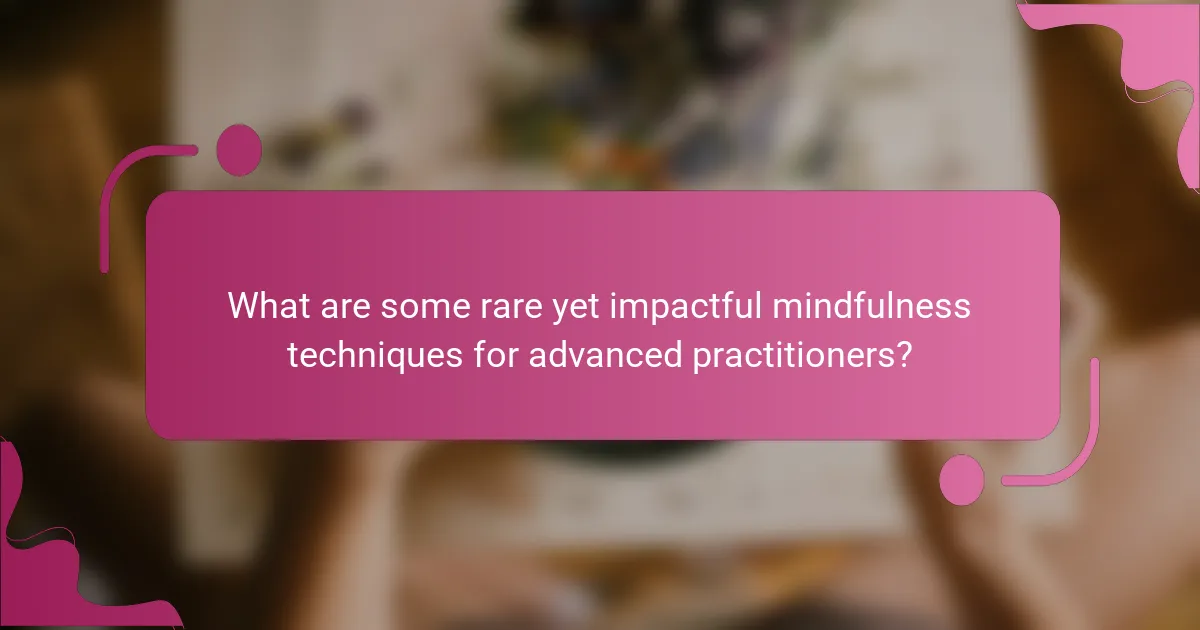
What are some rare yet impactful mindfulness techniques for advanced practitioners?
Advanced practitioners can explore rare mindfulness techniques such as sound meditation, body scan with visualization, and mindful movement practices. These methods enhance emotional balance and personal growth by integrating unique sensory experiences.
Sound meditation uses specific frequencies to deepen focus, promoting relaxation and clarity. Body scan with visualization combines traditional scanning with imaginative imagery, fostering a profound connection between mind and body. Mindful movement practices, like tai chi or qigong, encourage awareness through fluid motion, enhancing stress reduction.
These techniques are often overlooked yet can significantly impact an advanced practitioner’s journey. Engaging in these practices can lead to enhanced emotional resilience and deeper self-awareness.
How can visualization be combined with mindfulness for deeper insight?
Combining visualization with mindfulness enhances insight by fostering deeper awareness and focus. Visualization techniques, such as guided imagery, can amplify the effects of mindfulness meditation by creating vivid mental representations of calm and balance. This practice encourages emotional regulation and reduces stress. Engaging multiple senses during visualization strengthens neural pathways associated with positive experiences, leading to greater emotional resilience. Mindfulness enhances the clarity of these visualizations, allowing for more profound personal growth and insight.
What unconventional mindfulness practices can enhance personal growth?
Unconventional mindfulness practices that enhance personal growth include forest bathing, sound meditation, and mindful walking. Forest bathing immerses individuals in nature, promoting stress reduction and emotional balance. Sound meditation uses sound waves to facilitate deep relaxation and self-awareness. Mindful walking encourages presence and connection with surroundings, fostering clarity and insight. Each practice offers unique attributes that support personal development, making them valuable additions to traditional mindfulness techniques.
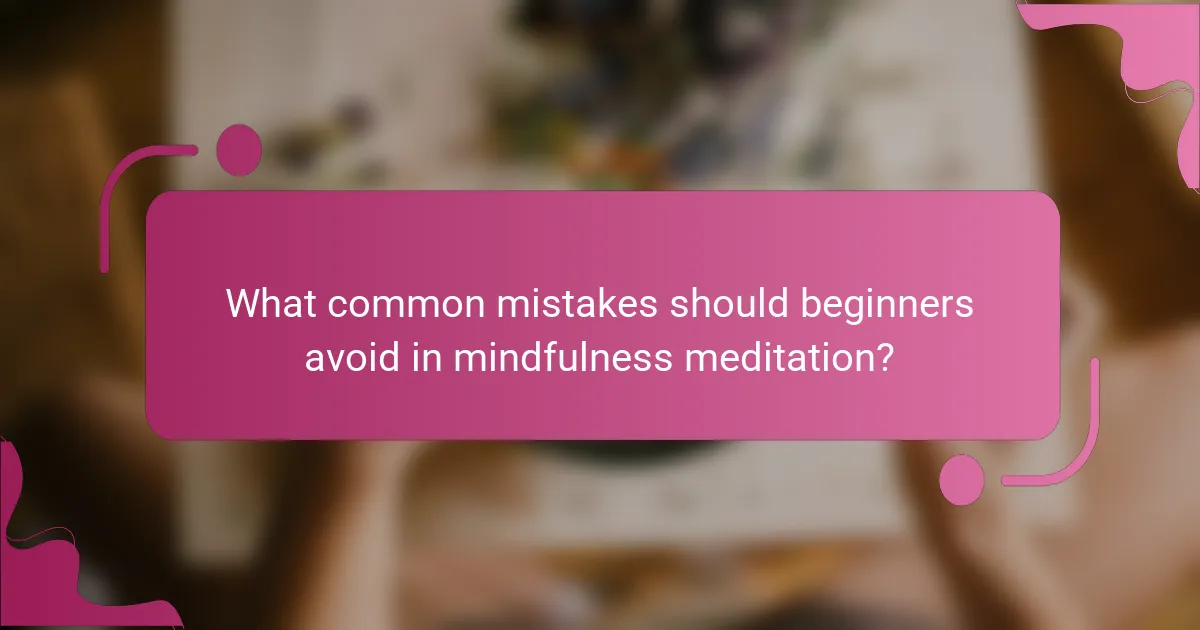
What common mistakes should beginners avoid in mindfulness meditation?
Beginners in mindfulness meditation should avoid common mistakes like expecting immediate results, being overly critical of their thoughts, and skipping regular practice. These pitfalls can hinder stress reduction and emotional balance.
One significant mistake is trying to clear the mind completely. Instead, focus on observing thoughts without judgment. Another error is neglecting the breath; maintaining awareness of breathing enhances the experience. Lastly, beginners often practice in distracting environments, which disrupts concentration. Creating a calm space fosters deeper engagement and personal growth.
How can practitioners ensure consistency in their mindfulness practice?
Practitioners can ensure consistency in mindfulness practice by establishing a regular schedule, creating a dedicated space, and using guided resources. Regular practice, ideally at the same time each day, reinforces habits and deepens focus. A designated space minimizes distractions and fosters a conducive environment. Utilizing guided sessions or apps can provide structure and variety, enhancing engagement. These strategies collectively support sustained mindfulness, promoting stress reduction and emotional balance.
What expert tips can enhance the effectiveness of mindfulness meditation?
To enhance the effectiveness of mindfulness meditation, focus on consistency, technique variety, and environment. Establish a daily practice to build a habit, aiming for at least 10 minutes each session. Experiment with different techniques such as body scan, breath awareness, and loving-kindness meditation to find what resonates best. Create a calming environment by minimizing distractions and incorporating elements like soft lighting or soothing sounds. As a result, these tips foster deeper engagement and greater benefits in stress reduction, emotional balance, and personal growth.
